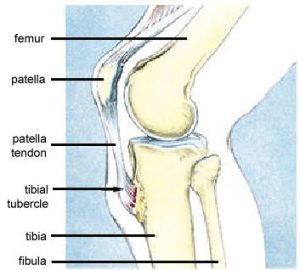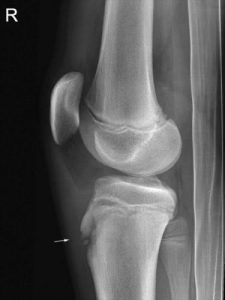
Osgood-Schlatter’s is a disease which affects children and is the lump that you can see on the front their shin below their kneecap. The good news is this pain eventually goes away when you child has finished growing and there are some things you can do to help manage their symptoms until then.

Anatomy
The knee has two growth plates which are active bone regeneration that stay open until children have stopped growing. There is one on the lower part of the thigh bone and one on the top of the shin bone.
Pathology
This is an overuse injury and usually occurs in children between 9-14 years of age.
When the body has a sudden growth spurt there is lots of activity as the growth plates are laying down a lot more bone cells. Then when the tendons around the knee start pulling on this bone, it causes some irritation and inflammation. This occurs right at the front of the knee at the top of the shin bone where the tendon from the thigh muscles attaches below the kneecap. It becomes inflamed and sore.
Symptoms
- Tender when pushing on the front bone of the knee and along the tendon that comes from the kneecap to this bone.
- It may be hot to touch and you will notice some inflammation around the bony insertion.
- There is a bony protrusion visible on the front of the knee below the kneecap.
- There is pain on walking up hills, straightening knee under load, kneeling, and doing activities such as running and jumping.
- The pain is relieved by rest and these children wake up with no symptoms in the morning.
Treatment
The first and most important stage of treatment is to manage the pain and inflammation.
- You need to de-load the patella tendon. Rest is the best way to start. This may need to be complete rest initially but depends on the severity of the pain.
- Activity medication is required. This may mean looking at what activites your child is doing over a week and taking out some of them to see if the reduction in load helps.
- Change in load is also a good idea for example if you are doing lots of sports with jumping and then some biking and swimming. Taking out the jumping/running activities in the short term means your child is still getting some load through their legs but not aggravating the Osgood Schlatters.
- Soft tissue massage into the lower legs may be helpful
- Gentle stretches that give some tension but not a big pulling feeling are good to keep everything mobile.
- Local antiinflammatory cream onto the front of the shin may help settle some of the inflammation
The second stage is when the pain is less and you have a window of opportunity to do some activity and get some good strength and control in the legs.
- Low-intensity isometric strength training with a focus on the quadricep muscles is a good start. This is where you hold the pushing movement of your lower leg as you are trying to straighten your knee against a resistance. You can do this in 3 different angles of knee straightening. 10 seconds x 4 in each angle is a good place to start.
- Adding in different exercises once these are successful is a matter of what is tolerable and what equipment you have. The focus needs to be on the whole lower limb including the calf, front of shin muscles, hamstrings, quadriceps and all the muscles around the hip and pelvis. This may including glute bridges, hamstring curls, calf raises, heel walking, banded side walking, single leg squats etc.
- As the load becomes more tolerable you will need to add in some more dynamic load such as skipping, lateral and forward bounds, hopping, box jumps on and off etc.
- Specific return to sport activities also help the successful loading program and limit recurrence so looking at graduated load of kicking, sprinting, changing direction, stop start etc depending on the demands of your specific sport.
Other things to keep in mind are
- Having a good warm up to gradually build some heat in the muscle pre activity
- Wearing appropriate sports shoes for activities but also looking at school shoes, home shoes and casual shoes so they are also providing the best control of the feet.
- Having good education and communication with you child so that if they are experiencing a recurrence they can let you know early and you can work together to modify their load management plan before it gets too bad.
The sooner an injury is identified, the sooner proper treatment can begin. The result is less aggravation, shorter healing time and faster return to sport.
